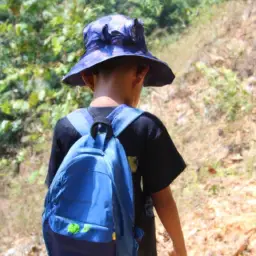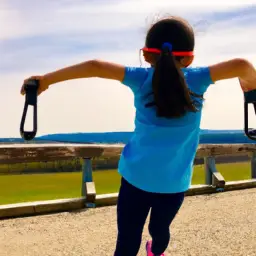Are you concerned that your child lacks the perseverance needed to succeed in life? Do you want to instill in them the attitude of never giving up, no matter how difficult the task may seem?
Then, you’ve come to the right place! In this article, we’ll explore the fundamentals of grit and give you practical tips on how to nurture this essential trait in your child.
Grit is the ability to persevere through challenges and setbacks, to stay committed to long-term goals, and to maintain a positive attitude in the face of adversity. It’s a crucial skill for success in all areas of life, from academics to sports to career.
Fortunately, grit is not an innate quality but can be developed through intentional practice and reinforcement. By following the strategies outlined in this article, you can help your child cultivate a gritty mindset that will serve them well throughout their lives.
Key Takeaways
- Grit is a crucial skill for success in all areas of life and can be developed through intentional practice and reinforcement.
- Goal-setting, planning, and accountability are important components of developing perseverance in children.
- Encouraging risk-taking and flexibility, as well as teaching children to adjust their plans as needed, helps develop resilience and adaptability.
- Reinforcing grit through positive feedback and recognition for effort put in, rather than just the outcome, helps children develop skills needed to succeed in all areas of life.
Understanding the Concept of Grit
You’ll need to picture perseverance and determination as the building blocks of grit, because that’s what this subtopic is all about. Understanding grit is crucial if you want to instill a sense of perseverance in your children.
Grit is a personality trait that describes someone’s ability to stick with a task despite setbacks, failures, or obstacles. It’s what separates successful people from those who give up too easily.
The importance and benefits of grit cannot be overstated. Research has shown that people with grit are more likely to achieve their goals, earn higher salaries, and be happier in life. Gritty individuals are also more resilient and better equipped to handle stress and challenges.
Grit is not just about being tough, though. It’s about having a growth mindset and being willing to learn from mistakes and failures. So, when it comes to success, grit may be more important than talent. After all, talent can only take you so far, but grit can push you to go beyond your limits.
Identifying Opportunities for Grit Development
When looking for ways to help your kids develop a strong work ethic and resilience, it’s important to keep an eye out for situations that challenge them and push them out of their comfort zones. These are the grit building environments that can help your children develop the determination to overcome obstacles and persevere through difficult times.
Whether it’s signing up for a challenging extracurricular activity or encouraging them to take on a new hobby, finding opportunities for your children to stretch themselves will help them build the mental toughness they need to succeed in life.
Another way to help your children develop grit is by leveraging setbacks. Failure is a natural part of life and learning how to bounce back from it is an important skill for children to develop.
When your child experiences a setback, instead of immediately rushing in to solve the problem for them, encourage them to find their own solutions and take responsibility for their actions. This will help them build resilience and develop the mindset that challenges are opportunities for growth.
By creating an environment that fosters grit, you can help your children develop the determination and perseverance they need to succeed in whatever they choose to do.
Modeling Gritty Behavior
By embodying gritty behavior yourself, you can inspire those around you to push through challenges and achieve their goals. Leading by example is one of the most effective ways to teach perseverance to children.
When they see you persistently working towards your own goals, they will learn to value that behavior and emulate it in their own lives. Encouraging persistence is another way to model gritty behavior.
When children encounter obstacles, it can be easy to give up and move on to something else. However, by encouraging them to persevere and keep trying, you are teaching them that failure is not the end of the road. Instead, it is an opportunity to learn and grow.
By instilling this mindset in children, you are giving them the tools they need to succeed in all areas of their lives.
Cultivating a Gritty Mindset
So, you wanna cultivate a gritty mindset in yourself or your child? That’s great!
It all starts with developing self-discipline and self-control, which will help you stay focused and on track towards your goals.
Building confidence and resilience will also be key, as setbacks are inevitable in life.
And lastly, don’t forget to foster a positive attitude – it may not change your circumstances, but it will change how you approach them.
Developing Self-Discipline and Self-Control
It’s crucial to teach kids how to develop self-discipline and self-control if we want them to succeed in life. Developing habits that promote self-discipline and self-control is an excellent way to instill perseverance in children.
Encouraging them to practice activities that require focus and repetition, such as playing a musical instrument or participating in sports, can help them develop the necessary skills to regulate their behavior and emotions.
Emotional regulation is also a crucial aspect of developing self-discipline and self-control. Teaching children how to identify and manage their emotions can help them stay focused and motivated when faced with challenges.
Encourage them to express their feelings in a healthy way, such as journaling or talking to a trusted adult. With your guidance and support, they can learn to navigate their emotions and develop the resilience needed to persevere through difficult situations.
Building Confidence and Resilience
You can build up your confidence and resilience by facing challenges and overcoming them. It could be as simple as climbing a mountain or completing a difficult project. Whatever it is, the key is to push yourself out of your comfort zone and take on something that seems difficult or impossible. By doing so, you will learn coping strategies to deal with setbacks and failures, and you will develop a mindset that sees challenges as opportunities for growth.
To boost your confidence, it’s important to engage in positive self-talk and to overcome self-doubt. This means focusing on your strengths rather than your weaknesses, and reminding yourself of past successes. It also means challenging negative thoughts and replacing them with positive ones. For example, instead of thinking "I can’t do this", try saying "I can do this if I put in the effort". By practicing these mindset shifts, you can build resilience and confidence that will help you overcome obstacles and achieve your goals.
| Developing resilience | Boosting confidence | ||
|---|---|---|---|
| Identify your triggers for stress and anxiety | Focus on your strengths | ||
| Use relaxation techniques such as deep breathing or meditation | Practice positive self-talk | ||
| Seek support from friends and family | Challenge negative thoughts | ||
| Learn from your mistakes and failures | Celebrate past successes | ||
| Focus on the present moment rather than worrying about the future | Set achievable goals for yourself | Take care of your physical health through exercise, healthy eating, and self-care practices. |
Fostering a Positive Attitude
Fostering a positive attitude can be the key to unlocking a happier and more fulfilling life. As a parent, it’s important to encourage your child to approach challenges with a positive outlook.
Here are three ways to do so:
-
Use positive reinforcement: Instead of focusing solely on the end result, praise your child’s efforts and progress along the way. This helps them develop a growth mindset and understand that mistakes and failures are opportunities to learn and grow.
-
Model positivity: Children often mimic the behaviors and attitudes of those around them. By maintaining a positive outlook and attitude, you can help your child adopt the same mindset.
-
Encourage optimism: Help your child see the good in every situation and focus on the possibilities and potential outcomes. This can help build resilience and perseverance in the face of challenges.
With your support and guidance, your child can develop a positive attitude that will serve them well throughout their life.
Practicing Grit Through Activities and Exercises
Now, let’s focus on practicing grit through activities and exercises.
To develop perseverance, you need to set goals and plan your actions accordingly. Mindfulness and self-reflection are also crucial in building resilience.
Additionally, physical exercise and endurance training can help you push through difficult situations and overcome challenges.
Goal-Setting and Planning
When it comes to instilling perseverance in children, goal-setting and planning are crucial components that shouldn’t be overlooked.
Creating accountability is an important part of goal-setting. Children should be encouraged to set their own goals, whether it’s achieving a certain grade in school or learning a new skill.
Once they have set their goals, they should be held accountable for working towards them. This can be done through regular check-ins and progress reports.
Encouraging flexibility is another important aspect of goal-setting. Children should be taught that setbacks and obstacles are a natural part of the process and that it’s okay to adjust their plans as needed.
This will help them develop resilience and adaptability, which are key traits of grit. Additionally, children should be taught to break down their goals into smaller, more manageable tasks.
This will make the goals feel less daunting and more achievable, which will ultimately help them stay motivated and persevere through challenges. By nurturing these skills early on, children will be better equipped to face the inevitable obstacles that arise throughout life.
Mindfulness and Self-Reflection
Practicing mindfulness and taking time for self-reflection allows you to become more aware of your thoughts and emotions. This leads to a clearer understanding of your own motivations and behaviors. By doing so, you can identify patterns and habits that may be hindering your progress towards achieving your goals.
One effective way to practice mindfulness is through journaling. A journaling practice allows you to record your thoughts and feelings, which can help you identify areas where you may need to make adjustments in your life.
Additionally, incorporating mindful breathing techniques into your daily routine can help you stay centered and focused, even in the midst of chaos.
Overall, taking the time to be mindful and reflect on your experiences can help you build resilience and develop grit.
Physical Exercise and Endurance Training
Getting regular exercise and incorporating endurance training into your routine can help you build physical strength and mental resilience.
Endurance challenges like running, hiking, or cycling can be great ways to push your limits and develop grit. By setting a goal and working towards it, you can build the perseverance and determination necessary to overcome obstacles and achieve success.
Outdoor activities like hiking or camping can also be great opportunities to build grit. These activities often require physical endurance and mental toughness, as you navigate unfamiliar terrain and face unexpected challenges.
By pushing through discomfort and persevering to reach your destination, you can develop the resilience and perseverance necessary to overcome obstacles in other areas of your life.
So, next time you’re looking to build grit in yourself or your child, consider incorporating regular exercise and endurance challenges into your routine.
Reinforcing Grit Through Positive Feedback and Recognition
By acknowledging a child’s efforts and progress, parents and educators can effectively reinforce grit and encourage perseverance. Praising a child’s hard work and determination instead of solely focusing on their achievements can help them develop a growth mindset and understand that failure is a natural part of the learning process.
It is important to recognize that grit is not just about toughness and resilience, but also about the willingness to take risks and learn from mistakes. Encouraging risk-taking can be a powerful tool in building grit. When a child takes on a challenge that requires them to step out of their comfort zone, they’re more likely to develop perseverance and resilience.
It’s important to provide positive feedback and recognition for the effort put in, rather than just the outcome. This will help to instill a sense of pride and self-worth in the child, which can motivate them to continue working hard and pushing themselves towards their goals. By reinforcing grit through positive feedback and recognition, parents and educators can help children develop the skills they need to succeed in all areas of life.
Frequently Asked Questions
What are the negative effects of pushing children too hard to develop grit?
Pushing children too hard to develop grit can have negative effects on their overall well-being. While it’s important to instill perseverance in children, it’s equally important to balance it with self-care.
Overemphasizing grit development can lead to burnout and anxiety, which can hinder academic and personal growth. Praising children for their efforts instead of just their achievements can help foster intrinsic motivation and a love for learning.
It’s important to remember that grit is not just about pushing through challenges, but also about knowing when to take breaks and practice self-care.
How can parents and educators address the unique challenges faced by children with disabilities when it comes to developing grit?
If you’re a parent or educator looking to help a child with disabilities develop grit, it’s important to take an individualized approach. This means recognizing that each child is unique and may face different challenges.
It’s also important to build strong support networks for these children, including family, friends, and professionals who can provide guidance and encouragement.
By working together and tailoring strategies to meet the specific needs of each child, parents and educators can help children with disabilities overcome obstacles and develop the resilience and perseverance they need to succeed.
Can grit be learned later in life, or is it something that needs to be instilled in childhood?
Learning grit in adulthood is possible, but it can be more challenging than instilling it in childhood. However, it’s never too late to develop perseverance.
One way to cultivate grit as an adult is by modeling it yourself. When you demonstrate determination and resilience in the face of adversity, you show others that it’s possible to overcome obstacles.
Another way to learn grit is through deliberate practice. This involves setting challenging goals, persisting through difficulties, and seeking feedback to improve. By adopting a growth mindset and embracing challenges, you can develop the grit needed to achieve your goals.
While it may be more difficult to learn grit in adulthood, the importance of modeling perseverance and deliberately practicing resilience cannot be overstated.
How can parents and educators balance the importance of developing grit with the need to allow children to have a balanced and enjoyable childhood?
Finding balance between developing grit and allowing children to have a balanced and enjoyable childhood is crucial for parents and educators. While developing grit is important, it shouldn’t come at the cost of a child’s happiness and well-being.
One way to achieve this balance is by emphasizing the importance of play. Encourage children to engage in activities that they enjoy and that challenge them, but also allow them to have unstructured playtime where they can explore and be creative.
Additionally, it’s important to model perseverance and resilience in your own life, and to praise effort over achievement.
By finding this balance, you can help instill grit in your child while still allowing them to have a fulfilling childhood.
Are there any cultural or socio-economic factors that can impact a child’s ability to develop grit?
Cultural influences and economic factors can greatly impact a child’s ability to develop grit. Depending on their cultural background, children may be taught different values and beliefs that encourage or discourage perseverance in the face of challenges.
Additionally, economic factors, such as access to resources and opportunities, can greatly impact a child’s ability to develop grit. For example, children living in poverty may face more obstacles and have fewer resources available to help them persevere through difficult situations.
It’s important for parents and educators to be aware of these factors and work to provide support and resources to help all children develop grit, regardless of their cultural or economic background.
Conclusion
So, there you have it. You now understand the fundamentals of grit and how to instill perseverance in children. It’s not an easy task, but with patience, consistency, and the right mindset, it can be done.
Remember to identify opportunities for grit development, model gritty behavior, cultivate a gritty mindset, practice grit through activities and exercises, and reinforce grit through positive feedback and recognition.
By teaching children the importance of grit, you’re setting them up for success in all areas of life. They’ll learn to face challenges head-on, persist through difficulties, and ultimately achieve their goals.
As a parent, teacher, or mentor, you have the power to shape the future of the next generation. So, go out there and help your children develop grit – it’ll make all the difference.



































































































